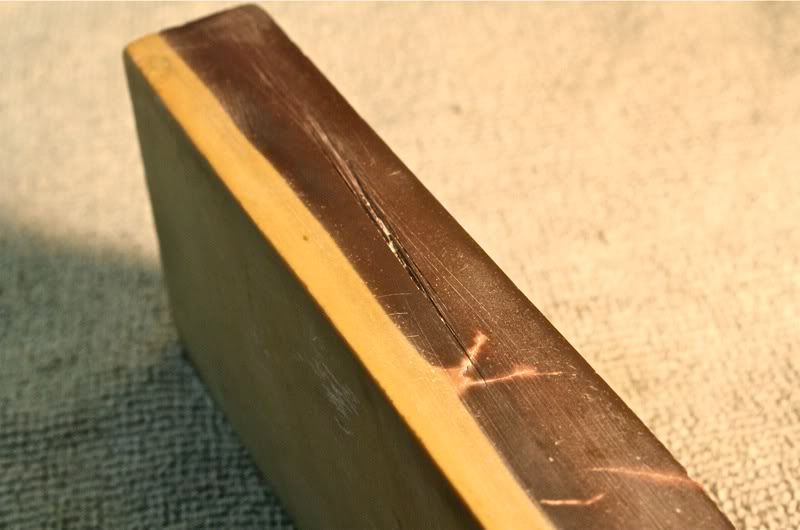Results 1 to 10 of 20
-
03-03-2010, 12:16 AM #1
 Barber Coticule, grooved by rounding off spike points?
Barber Coticule, grooved by rounding off spike points?
Recently picked up an old "barber's coticule," about 5" x 2.5" x 0.9". I like this size very much for hand-held honing, and look for them when I can.
Anyway, I noticed that the stone has deep grooves or cuts, on the sides only, and only in the BBW portion. These appear to me to be deliberate and not the result of abuse, because both honing surfaces are intact.
I read somewhere on the forum recently that in the heyday of spike point razors, some barbers would round off the sharp points of their customers' spike razors by using the area on the sides of their honing stones. This made perfect sense to me, but I haven't seen an example of it in person until I got this stone (I think...)
So what do y'all think went on here: abuse, or spike-rounding?


-
03-03-2010, 12:25 AM #2

I would think a skilled barber would round spikes by lifting the tang and/or spine during honing, but who knows how it was commonly done.
We can only speculate, but I speculate that is not from muting spikes.
-
03-03-2010, 01:11 AM #3Senior Member

- Join Date
- Apr 2009
- Posts
- 786
Thanked: 132
Major congrats!
I woulnt mind one like that sometime.
Mac
-
The Following User Says Thank You to McWolf1969 For This Useful Post:
FatboySlim (03-04-2010)
-
03-03-2010, 01:20 AM #4

My bets are that his wife commonly used it to keep a nice point on her sewing needles. As Holli4 pointed out, a skilled barber would likely mute the spike differently. I have seen a bunch of old barber hones with marks like that all over the back of them. I would guess the side would be the best place for that kind of sharpening on a combo coticule.
-
03-03-2010, 02:02 AM #5Electric Razor Aficionado

- Join Date
- Apr 2006
- Posts
- 3,396
Thanked: 346
either from sharpening needles or fish hooks
-
The Following User Says Thank You to mparker762 For This Useful Post:
FatboySlim (03-04-2010)
-
03-03-2010, 03:49 AM #6Junior Member

- Join Date
- Jan 2010
- Location
- Idaho
- Posts
- 21
Thanked: 5
From page 18 of Shaving Made Easy, Circa 1905: "If you have a razor with a sharp point, you can round it off, on the edge of the hone. You should not use the top surface of the hone for this purpose, for if you do you are quite likely to scratch the hone and spoil it. Use water freely otherwise the blade will become heated and that would quickly spoil its temper" (italics in original).
-
The Following User Says Thank You to dericandteri For This Useful Post:
FatboySlim (03-04-2010)
-
03-03-2010, 04:03 AM #7

Tim, obviously you've got a problem. CAD. I can help you if you'll let me. Send me all but one of your coticules . The first step is admitting you have a problem.
 Then it is staying away from people places and things.
Then it is staying away from people places and things.  Be careful how you treat people on your way up, you may meet them again on your way back down.
Be careful how you treat people on your way up, you may meet them again on your way back down.
-
The Following User Says Thank You to JimmyHAD For This Useful Post:
FatboySlim (03-04-2010)
-
03-03-2010, 04:06 AM #8

Quite interesting theory. I would look at that and assume it was from whatever tool was used for extraction of the stone or think it was a natural groove. Am interested in learning more about this.
-
03-04-2010, 01:03 AM #9

Thanks for the feedback guys. I was debating whether to keep the marks or lap them out. Grooves from sharpening fish hooks are a possibility, since it came from an Atlantic coastal town. And coticules were apparently quite cheap at one time; one coticule natural I have came in an old box originally marked "Belgian Hone - $4". So someone back then might sharpen their fish hooks on a coticule as readily as a carborundum or arkansas stone. But I would never think to sharpen fish hooks on a coticule that I also used to sharpen razors to shave with.
The grooves are a perfect fit for a 5/8ths spike point I have, but that really doesn't mean much. A knife blade for a very small or fine knife could leave the same marks and have the same fit. Perhaps it was used for taking chips out of pocket knife edges before sharpening them.
HAD is a progressive disease. It starts with simply using the stones, then it progresses on to looking at them under strong light, contemplating them.
-
The Following User Says Thank You to FatboySlim For This Useful Post:
McWolf1969 (03-06-2010)
-
03-04-2010, 02:13 AM #10

I'd say leave them as is. I wouldn't think they would affect the functionality of the hone, and removing them would leave you with a narrower honing surface.


 LinkBack URL
LinkBack URL About LinkBacks
About LinkBacks






 Reply With Quote
Reply With Quote

